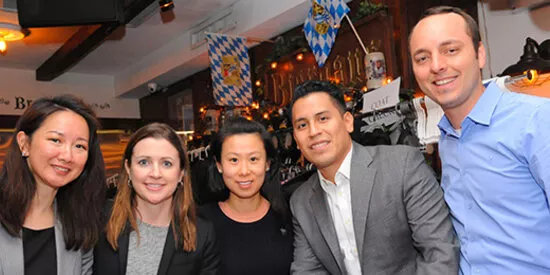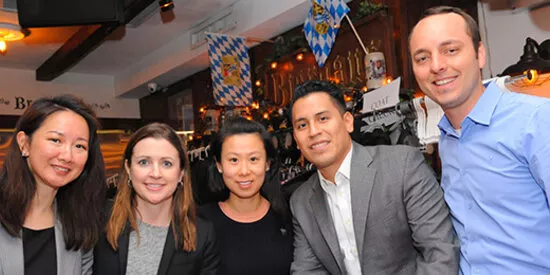
Reverse Mentoring: Beyond Technology
Reverse mentoring usually brings to mind a young employee tutoring an older one about technology and social media. That's what former GE CEO Jack Welch had in mind when he championed the practice in 1999, famously pairing 500 senior executives with an equal number of junior associates.
At Societe Generale Americas, it's proving to be a powerful tool for fostering greater inclusion in the workplace. Pride & Allies, one of the bank's Employee Resource Groups (ERGs), has a reverse mentoring program that matches mentors from the bank's LGBTQ community with mentees who are more senior at the bank, for a series of four, one-hour monthly meetings.
Ryan Fleer, an analyst in the bank's equity derivatives middle office and himself a mentor, currently runs the reverse mentoring program, now in its second cycle. Though Ryan says he has always felt comfortable being out at the bank, he recognizes that's not the case for everyone. "There are people who don't feel comfortable being expressive about their sexual orientation or their gender identity in the workplace, and we do respect that," he says. "For those who do want to express themselves, we can help ensure the bank is a welcoming, safe place by raising awareness outside of the community."
The real power of the program, according to participants, is the chance for people to hear each other's stories, develop empathy, and find common ground. "To be able to put myself in someone else's shoes, I have to educate myself, and that means speaking with people who have different experiences and points of view," says Nancy Harrington Jones, Chief Culture & Conduct Officer for the Americas. "Even though we say it's ok to ask questions, sometimes in a corporate setting it's not easy. This program made me feel more informed, and the structure was designed to allow a very comfortable, open relationship to develop."
She points out that lack of inclusion often stems from lack of awareness, rather than resistance. "I don't put that on the minority to resolve, but sometimes I don't even know the questions to ask." Nancy ended up sharing the curriculum from the program with her team. "Everybody can learn something," she says.
And that includes mentors as well. Ryan says he's learned how important it is for mentors to listen to mentees. "They have stories too, and it's very encouraging to hear how motivated they are to really drive change."
Gordana Pantic, Managing Director, Regulatory Remediation Manager, became a mentee because she wanted both to show her support and learn how she could make a difference. "In this day and age it is inexcusable to still have this as an issue," she says. Though she is an ally in the Pride and Allies group, she found being mentored eye-opening. "As much as you think you might know, I am now more mindful of what could be insensitive or inappropriate and I speak up when needed." She says employees are grateful rather than resentful when that's the case. "I have people come to me and say, `thank you, I wasn't thinking about it.' They listen and appreciate seeing senior people being involved and caring."
The involvement of senior people is one of the keys to success with the programs, says Ryan. "As with any change initiative, you start at the top and the behavior and beliefs trickle down."
According to Gordana, the reverse mentoring program mirrors others she has experienced. "The objectives are the same: How to express yourself, how to feel comfortable at work, and how to advance your career," she says. "My two mentors are both young and were concerned about how they might be perceived, but this initiative is giving them the freedom to be who they are and be themselves at work."
She hopes the similarity of goals will not only encourage people to get involved with the reverse mentoring program, but with other programs as well. "I hope that if I can show members of the LGBTQ community that I am their ally, that they might want to be an ally for another group. We need to be mindful that every group has its troubles and challenges, and that support is a two-way street."
That point is underscored by the theme of the first module, "A Closet is No Place to Live." Says Ryan, "LGBTQ people have a closet, but so do other people. In the first session, we draw the mentee into the program by encouraging them to see what closets they have in their lives."
The themes of the other modules are "Diversity is More Than What We See," "Listening Is an Act of Love," and "Better You, Better Us." In the second module, the focus is on helping people understand the difference between sex, gender, orientation, and identity, and how those can influence the feeling of not belonging. As in the first module, both mentors and mentees are encouraged to share their stories.
For Ryan, the third session is the most powerful. "Vulnerability is a big topic of that session," he says. "When you go into the workplace, you can choose to be vulnerable or you can choose to hide yourself and cover." The emotional and mental toll of covering can inhibit an employee's performance at work, he points out. "If they can embrace the vulnerability, they really can bring their best selves to work."
The ally community's role is emphasized in the final session. "We need to help people understand that even if they're not LGBTQ, they have a big role to play in having an authentic and engaging workplace," he says.
Ideally, though, the effect goes beyond the workplace. Mentees have shared that what they've learned has helped them be more empathetic, aware and understanding of LGBTQ people and issues in their personal lives and feel empowered to speak up when necessary. "When I hear that, it makes me feel that this is really having an impact," says Ryan. "We're helping steer people in the correct direction both in the workplace and out in the world itself."



